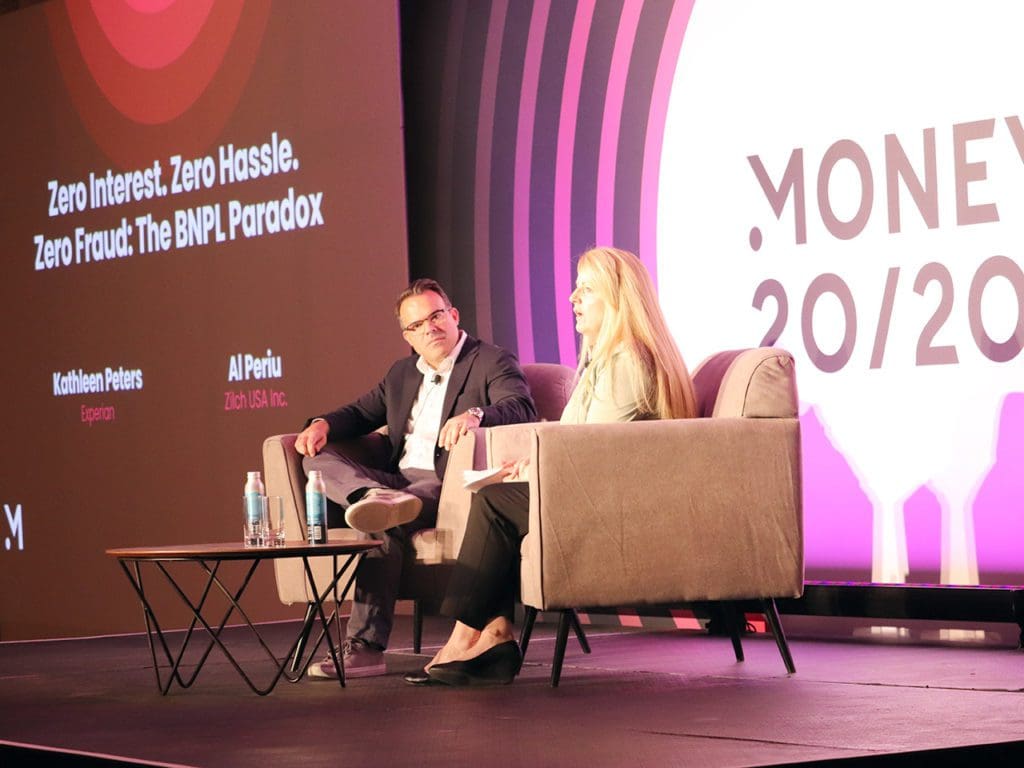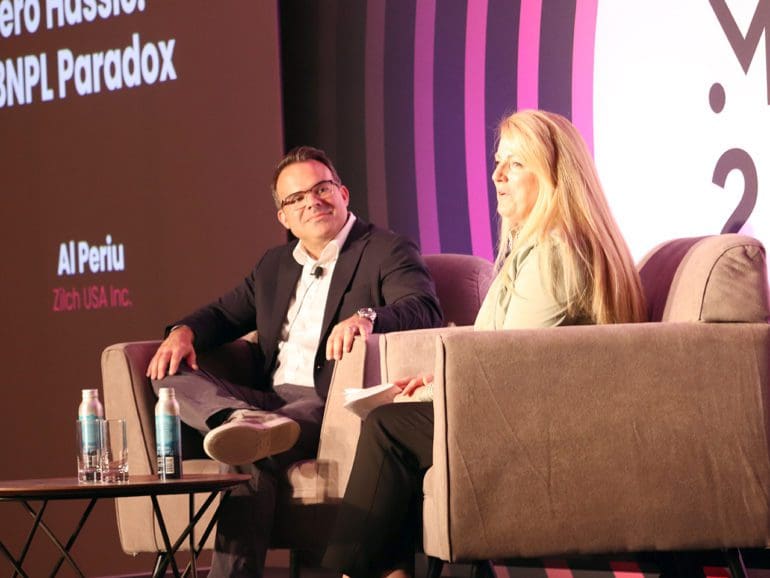LAS VEGAS, Nev. — The drive to find no-interest credit options during an economic downtown greatly accelerated Buy Now, Pay Later (BNPL) adoption in the U.S. in 2022, according to data shared by Experian at Money 20/20 last week.
The session titled Zero interest. Zero Hassle. Zero Fraud: The BNPL Paradox featured Kathleen Peters, Chief Innovation Officer, Fraud & Identity with Experian, and Al Periu, Chief Executive Officer of Zilch USA Inc.
The meteoric rise of buy-now-pay later created an all-important question in the fintech community: How do you harden security measures while preserving a user experience that facilitates growth?
According to Peters and Periu, the combination of human nature’s “path of least resistance” preference and the growing knowledge and appreciation of security measures employed by many BNPL providers drove exponential activity in the space.
Surveys over eight years
Peters noted that Experian has been doing an annual fraud/identity survey and report for the last eight years.
“We speak with thousands of consumers as well as businesses. One of the things that we talked about this time around is Buy Now, Pay Later,” Peters said. “We found that over 17 million consumers in the U.S. alone have been using BNPL, and over 25% of U.S. merchants incorporated aspects of BNPL into their checkout.”
Peters said 80% of consumers surveyed said one of the main reasons they liked BNPL was because it helped them avoid using their credit card and consequently avoid credit card interest.
Another major driver was convenience in the ease of use in the checkout process, Peters added.
“But what we find is that convenience and that ease of use can open the door to fraudsters,” she said. “Does the increase in fraud matter or is that just the cost of doing business?”
If it’s “the cost of doing business,” Periu said it comes with a hefty price.
Fraudsters see opportunity
“It’s shifting quickly with the current environment. The cost of doing business with this is a considerable line item,” Periu said. “Here particularly as fraudsters start to really zero in in a way they didn’t before with BNPL. Now they see it as an opportunity. Maybe it’s fresh ground to try some of the tricks they’ve used in other industries.”
Peters suggested up until recently, fintechs have been hiring fraud prevention staff late in the process, an approach that will need to change.
“When we’re staffing up companies in high growth mode, high return mode, maybe the fraud department is one of the later ones to be staffed. Fraudsters are sophisticated enough to know this can be the case, and as new products are offered, they see that as a rich target,” Peters said.
Periu said spiking fraud rates will get the attention of C-suites everywhere.
“The attention is now here. You’re seeing those fraud rates spike,” Periu noted. But any expectation of an off-the-shelf silver bullet are well premature, he said.
“As an industry, it’s very collaborative, but I don’t know if anyone has a specific silver bullet because I don’t think there is one. We have to keep adding more tools and increasing communications as an industry around this.”
All about layers
Peters felt a layered approach is absolutely critical.
“Whether you’re looking for first-party fraud, third-party fraud, or synthetic identity fraud, you need to be aware of the different types of behavior associated with those fraud types,” Peters said.
“Especially with BNPL, we’re going to see some early-stage folks that may not have shown up on the watch list in the past that are going to start to represent in first-party fraud. Part of the challenge is trying to distinguish what is bad credit, what is the loss associated with just bad debt, and how to compare that fraud?”
Periu said one saving grace is the relatively young age of fintech.
“The silver lining is a lot of our businesses are relatively new; they’ve not been around for decades. That means we don’t have a legacy tech stack,” Periu said.
Periu said it compels an ongoing and evolving pivot, illustrating an evolution that acknowledges fintech is a significant part of the lending and payments industry.
Related:
Back to school
Both panelists agreed that education matters.
“Tell them why they’re doing [security steps], with seminars, on the website, and in your marketing. We’re doing this not just to protect us but to protect you and to offer you the best products we can,” Periu said.
Peters added that the data shows consumers are becoming better educated about fraud, but the industry needs to help consumers protect themselves.
“It’s on us to get that right and get that consumer experience and convenience right, while protecting them and our businesses from fraud,” Peters said.
Perhaps ironically, the painfully rapid spike of identity theft that has either touched everyone directly or peripherally through friends and family has driven the point home.
“There’s been more in the media and then the news about people’s identity being stolen. Folks are more aware of friends and family who have experienced some identity theft or loss associated with that. More than 70% of those we surveyed said they either have had that experience themselves or know someone who has,” Peters said.

Coming together
Perius said he has been encouraged by early signs of collaboration on that front.
“It’s early days but I do think the collaboration is happening,” Periu said. “The most important thing we could be doing as an industry is further open lines of communication. It’s happening, but I would love to see it at a more accelerated pace.”
Peters also said affordability should be a prime focus.
“That’s one of the great benefits that these types of payment models allow consumers, especially ones who are worried about extending credit, and getting into a bunch of credit card debt,” Peters said. “These types of choices enable opportunities for consumers who may not have another.”
Periu echoed Peters’ altruistic reminder.
“When you think about the tens of millions of consumers that have very limited access to credit, are credit invisible, or the credit they do have access to is extremely expensive, that’s not fair. How do we find a way to make that fairer for these folks?” Periu asked.
Peters said it all comes back to data.
“We have good models. In terms of the benefits that can come from sharing data, we can look for the behaviors that ultimately help us determine those folks who are less risky and put them on a happier, frictionless path,” Peters said.


